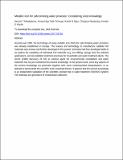| dc.contributor.author | Mwakabona, Hezron | |
| dc.contributor.author | Ndé-Tchoupé, Arnaud | |
| dc.contributor.author | Njau, Karoli | |
| dc.contributor.author | Noubactep, Chicgoua | |
| dc.contributor.author | Wydra, Kerstin | |
| dc.date.accessioned | 2023-10-03T09:54:42Z | |
| dc.date.available | 2023-10-03T09:54:42Z | |
| dc.date.issued | 2017-06-15 | |
| dc.identifier.uri | https://doi.org/10.1016/j.watres.2017.03.001 | |
| dc.identifier.uri | https://dspace.nm-aist.ac.tz/handle/20.500.12479/2095 | |
| dc.description | This research article was published by Elsevier Journal,Volume 117,in 2017, | en_US |
| dc.description.abstract | Around year 1890, the technology of using metallic iron (Fe0) for safe drinking water provision was already established in Europe. The science and technology to manufacture suitable Fe0 materials were known and further developed in this period. Scientists had then developed skills to (i) explore the suitability of individual Fe0 materials (e.g. iron filling, sponge iron) for selected applications, and (ii) establish treatment processes for households and water treatment plants. The recent (1990) discovery of Fe0 as reactive agent for environmental remediation and water treatment has not yet considered this ancient knowledge. In the present work, some key aspects of the ancient knowledge are presented together with some contemporised interpretations, in an attempt to demonstrate the scientific truth contained therein. It appears that the ancient knowledge is an independent validation of the scientific concept that in water treatment (Fe0/H2O system) Fe0 materials are generators of contaminant collectors. | en_US |
| dc.language.iso | en_US | en_US |
| dc.publisher | Pergamon | en_US |
| dc.subject | Research Subject Categories::NATURAL SCIENCES | en_US |
| dc.title | Metallic iron for safe drinking water provision: Considering a lost knowledge | en_US |
| dc.type | Article | en_US |

